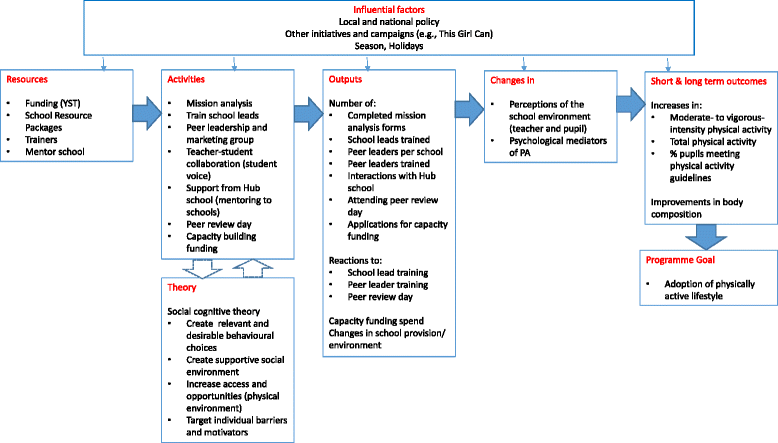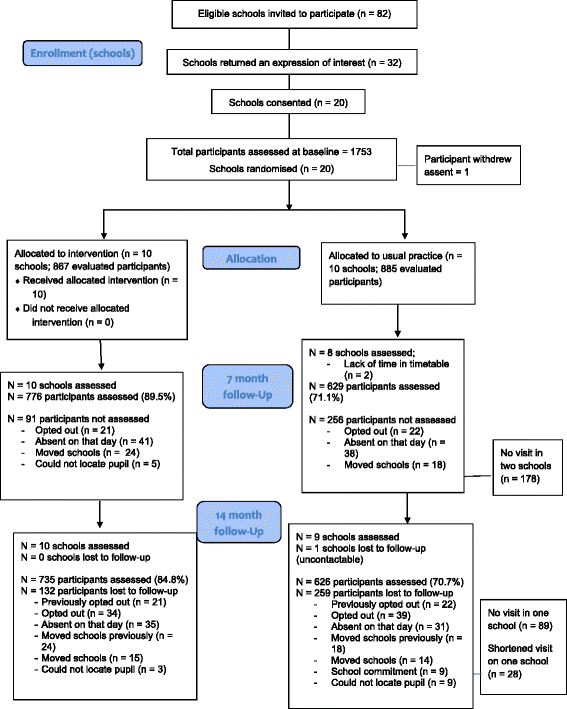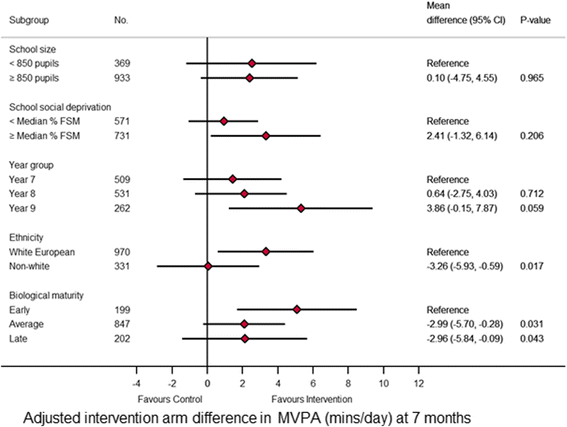Effectiveness of the 'Girls Active' school-based physical activity programme: A cluster randomised controlled trial
- PMID: 29695250
- PMCID: PMC5918764
- DOI: 10.1186/s12966-018-0664-6
Effectiveness of the 'Girls Active' school-based physical activity programme: A cluster randomised controlled trial
Abstract
Background: Globally, adolescent girls' physical activity (PA) levels are low. The 'Girls Active' secondary school-based programme, developed by the Youth Sport Trust, aims to increase PA in adolescent girls. This paper explores the effectiveness of the 'Girls Active' school-based PA programme.
Methods: A random sample of girls aged 11-14 from 20 secondary schools (Midlands, UK) participated in a two-arm cluster randomised controlled trial. Ten schools received Girls Active and 10 continued with usual practice. Measurements were taken at baseline, seven- and 14-month follow-up.
Primary outcome: wrist-worn accelerometer measured moderate- to vigorous-intensity PA (MVPA).
Secondary outcomes: overall PA, light PA, sedentary time, body composition, and psychosocial outcomes. Generalised estimating equations, adjusted for school cluster and potential confounders, were used and A priori subgroup analysis was undertaken. Micro-costing and cost-consequence analyses were conducted using bespoke collection methods on programme delivery information. Outcomes for the cost-consequence analysis were health related quality of life measured by the Child Health Utility-9D and service use.
Results: Overall, 1752 pupils participated, 1211 (69.1%) provided valid 14-month accelerometer data. No difference in MVPA (mins/day; 95% confidence intervals) was found at 14 months (1.7; -0.8 to 4.3), there was at seven months (2.4; 0.1 to 4.7). Subgroup analyses showed significant intervention effects on 14-month in larger schools (3.9; 1.39 to 6.09) and in White Europeans (3.1; 0.60 to 6.02) and in early maturers (5.1; 1.69 to 8.48) at seven months. The control group did better in smaller schools at 14-months (-4.38; -7.34 to -1.41). Significant group differences were found in 14-month identified motivation (-0.09; -0.18 to -0.01) and at seven months in: overall PA (1.39 mg/day; 0.1 to 2.2), after-school sedentary time (-4.7; -8.9 to -0.6), whole day (5.7; 1.0 to 10.5) and school day (4.5; 0.25 to 8.75) light PA, self-esteem. Small, statistically significant, differences in some psychosocial variables favoured control schools. Micro-costing demonstrated that delivering the programme resulted in a range of time and financial costs at each school. Cost-consequence analysis demonstrated no effect of the programme for health related quality of life or service use.
Conclusions: Compared with usual practice, 'Girls Active' did not affect 14-month MVPA.
Trial registration: ISRCTN10688342.
Keywords: Adolescent female; Intervention; Physical education; Teacher.
Conflict of interest statement
Ethics approval and consent to participate
Ethics approval was obtained from the College of Medicine, Biological Sciences and Psychology ethics representative at the University of Leicester. School principals provided written consent for their school to participate. Parents/guardians were provided with an opt out consent form and only pupils who did not return the opt out consent form participated. Participants provided verbal assent prior to each measurement session and could withdraw at any time.
Consent for publication
Not applicable.
Competing interests
All authors have completed the Unified Competing Interest form (available on request from the corresponding author) and declare: no support from any organisation for the submitted work, no financial relationships with any organisations that might have an interest in the submitted work in the previous three years and no competing interest related to this work. MJD and KK reports personal fees from Novo Nordisk, Sanofi-Aventis, Lilly, Merck Sharp & Dohme, Boehringer Ingelheim, AstraZeneca, Janssen, Servier, Mitsubishi Tanabe Pharma Corporation, Takeda Pharmaceuticals International Inc. and grants from Novo Nordisk, Sanofi-Aventis, Lilly, Boehringer Ingelheim, and Janssen. Outside of the submitted work, JC reports grants from Public Health Wales. CE reports grants from National Institute for Health Research Public Health Research during the conduct of the study. YC, TP, RTE, DB, TG, DMH, AR, LS and TY all have nothing to declare.
Publisher’s Note
Springer Nature remains neutral with regard to jurisdictional claims in published maps and institutional affiliations.
Figures




References
-
- Public Health England. Health Survey for England 2015, Trend Tables. Health and social care information Centre. Available from http://www.content.digital.nhs.uk/catalogue/PUB22610. Accessed 2 Jan 2018.
-
- UK Active Kids. Generation Active. Available from http://www.ukactive.com/downloads/managed/ON02629_UK_Active_Kids_report_.... Accessed 2 Jan 2018.
Publication types
MeSH terms
Associated data
Grants and funding
LinkOut - more resources
Full Text Sources
Other Literature Sources
Medical

